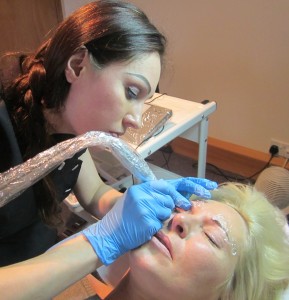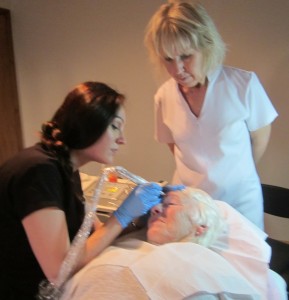Katia carries out Permanent Make-up Eyebrow Treatment
Katia had undergone previous permanent make-up training at a different establishment but was not happy with the training she had been given. She had not carried out enough practical work to give her the confidence to work. The theory involved with permanent make-up is extremely important to offer your clients treatment at the highest standard of health and safety, to achieve the correct colour choice and to find the perfect shape. Practical work is important because without the confidence to lay hands on your client no amount of theory is going to be helpful!
- During Katia’s one to one training course the first day covered theory and demonstration. She also practised different techniques on fake skin.
- The second day Katia carried out 3 permanent make-up eyebrow treatments. I always start the practical permanent make-up training with eyebrow treatments to give the student confidence.
Eyebrow hair strokes are the most popular treatments and it is important that these are applied to give a natural look as that is what many clients are looking for, especially more mature clients.
Permanent Make-up Eyeliner training
This was the procedure that Katia was most nervous about. Once Katia had mastered the technique of hand placement to ensure eye safety she became confident and mastered the procedure very quickly. If the permanent make-up technician is calm, this has a calming effect on the client who then feels confident in the technician’s ability.

Katia confidently carries out permanent make-up eyeliner training
Permanent Make-up Lip liner and Lip Blush training
Lip shape and colour choice is extremely important with this procedure. Learning to listen to what the client expects to achieve from the procedure will avoid client disappointment.
Final Assessment
Katia will return to the training rooms when she has completed 12 client case studies – 4 for each procedure – to show pictures of her work and consultation procedures. The insurance covers her to carry out these procedures but she must declare that she is a student and must charge a reduced fee. She will also carry out one of each procedure as a final assessment and on showing that her work is of a good standard will receive her diploma which will allow her to work as a permanent make-up technician.
Do you think you have what it takes to carry out permanent make-up?
Please contact me if you would like more information on permanent make-up courses.
